
Curated with aloha by
Ted Mooney, P.E. RET

The authoritative public forum
for Metal Finishing 1989-2025

-----
Toxicity of nickel silver flatware, p.2
< Prev. page (You're on the last page of the thread)
Q. I have a silver plate tea and coffee service from the 1850's: the outside can still be polished to a nice finish, but the inside is very dull, dark, and in some spots pitted. In your opinion, is it safe to drink from?
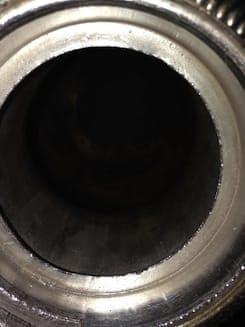
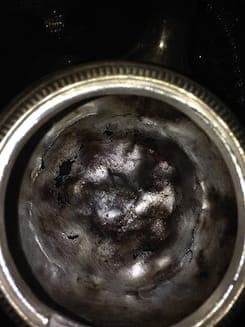
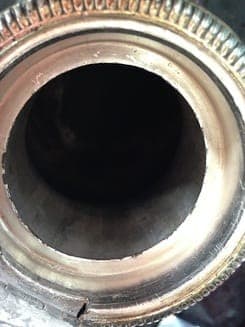
Thanks!
Leslie Galbraith- Toronto, ON, Canada
October 7, 2015
![]() Hi Leslie. I doubt that you will find any research or any definitive answers on this question, and there really isn't much point asking for ever final nuance and subtlety from my answers -- I'm just the website administrator, not some expert in the safety of worn silver. But I wouldn't use it, sorry. Maybe someone else will chime in :-)
Hi Leslie. I doubt that you will find any research or any definitive answers on this question, and there really isn't much point asking for ever final nuance and subtlety from my answers -- I'm just the website administrator, not some expert in the safety of worn silver. But I wouldn't use it, sorry. Maybe someone else will chime in :-)
Regards,

Ted Mooney, P.E. RET
Striving to live Aloha
finishing.com - Pine Beach, New Jersey
! Mr. Mooney, in a earlier comment you wrote "the best flatware is sterling silver". Despite its history, I'm beginning to question that (aesthetics aside). Recently I stumbled across a study in which participants were asked to suck on spoons made from different metals and rate their taste. The metals were gold, silver, stainless steel, zinc, copper, tin and chrome. Silver cutlery didn't fare so well, particularly with acidic foods. Gold and stainless steel came out top.
A news story discussing the study can be found here:
www.dailymail.co.uk/sciencetech/article-2949481
- Norfolk, Virginia USA
January 31, 2016
Ed. note: Thank you for the second opinion, Rob.
Q. After I cleaned these spoons
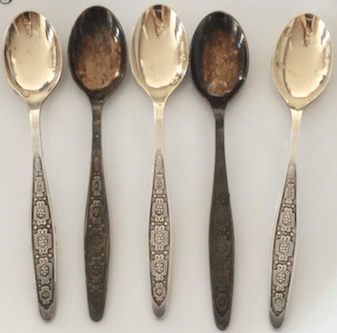
(all of them) it was more visible that the part that goes in the mouth is gold in color, and the handles are silver.
I don't know what metal they're made out of. Can you guess the metal, and the most important, are they safe to be used?
I hope they are not toxic, since I would like to use them often.
Thank you very much.
- Princeton, New Jersey
February 13, 2016

A. Hi Lilly. There are no markings at all on this set? As we learned from "The Dress" last year, it is difficult to identify a color in a photograph unless it is in the midst of familiar colors like grass and sky and fire engines. So I'll have to take your word that the part that goes in the mouth is gold colored.
Easiest thing to do is just try to taste the spoons. If they have no taste, they probably are gold plated; and I'm very confident that they are safe. If they taste metallic you are not going to want to use them anyway no matter how safe they are. Good luck.
Regards,

Ted Mooney, P.E. RET
Striving to live Aloha
finishing.com - Pine Beach, New Jersey
February 2016
A. It is my understanding that silver has antibacterial properties (and is thus employed in some specialized water filtration processes) which to me anyway, would indicate that your silver service would be fine to use, as long as it was clean and there are no other contaminants on it?
Ana von Bunners- vero beach, Florida, us
February 1, 2016
May 13, 2016
Hi, Ted!
I've enjoyed reading this informative thread.
I eat with a set of Stainless Steel flatware 18/8 from Japan. I've used them all the time, for almost 30 years. Only in the past year or 2, I started noticing that the spoons leave, on my Corelle ware bowls and some other ceramic mugs, a light gray ring around where I scrape the spoon, these rings are very faint but over time build up on the surface. At first, I thought I had lead in the natural salt that I used, and after I changed salts I still got more rings. I have tried everything I know, including Bon-Ami, to try to remove the rings and scrapes from these items. Nothing has worked. It seems very odd to me.
Could something be wrong with my SS Flatware, and is it safe?
I am especially interested in your answers, because I have a mysterious illness, that has only recently been connected with a deficiency in certain minerals in my body of Copper and Silver, this is with a very high level of Zinc.
So, for myself, I started using Silver Plated Silverware.
I have found new Silver Plated Silverware to be a slightly creamy looking Silver color, and old Silver Plated Silverware to be a more whitish looking Silver color. Is the Silver Plate on the outside of Silver Plated Items made up of Sterling Silver (Pure Silver), or is there something else mixed with the silver that they plate with?
I don't know if you can answer this next question. I have been looking at other Silver Plated items in the thrift shops and see they have many different types of markings and names, quite deceptive. Some newer items have no markings what so ever, they look like Silver Plated, but could be anything. Would these items have any Silver in them?
Thank you for your time!
Sara
- Bensalem, Pennsylvania
![]() Hi Sara. I'm just the site administrator posting the Q&A's, and have no training or experience in what is or isn't safe; But I do personally feel that in this age of GMOs & pesticides, and frequent e coli, listeria, & salmonella outbreaks it is a bit silly to ignore our food and focus instead on the service items which the food might touch while being served. Perhaps the hobgoblin phrase "heavy metals" is making everyone focus on the flatware instead of the food.
Hi Sara. I'm just the site administrator posting the Q&A's, and have no training or experience in what is or isn't safe; But I do personally feel that in this age of GMOs & pesticides, and frequent e coli, listeria, & salmonella outbreaks it is a bit silly to ignore our food and focus instead on the service items which the food might touch while being served. Perhaps the hobgoblin phrase "heavy metals" is making everyone focus on the flatware instead of the food.
Ceramic/porcelain is harder than metal, and it is not really unusual for metal items to leave gray marks on light colored ceramic. We have lots of inquiries here of how to get marks from rings out of white sinks and toilet bowls.
If flatware has no markings at all, sorry, but I don't think it is possible to guess what it might be from its shade.
Regards,

Ted Mooney, P.E. RET
Striving to live Aloha
finishing.com - Pine Beach, New Jersey
May 2016
Can we use nickel under gold plating on flatware?
Hi,
I'm from Vietnam and we are planning to get into high end cutlery business by using gold electroplating to decorate ordinary stainless steel (18/10 or grade 304 ) cutleries.
We intend to use the same electroplating method as for non-edible stainless steel accessories which consists of applying 2 layers of nickels then 1 layer of Cobalt-gold and final layer of nearly pure gold (using gold salt 68,3%).
However, for cutlery, our concern is whether the nickel layer would be toxic and create allergies to users as cutlery have direct contact to users especially when they are using them to eat food.
I'd like to seek your advice whether nickel can be acceptable or not in this case?
Many many thanks,
- Hanoi, Vietnam
August 20, 2017
? Hello, what will be the overall gold plating thickness counting both coatings?
Mark Bakerprocess engineering - Phoenix, Arizona USA
August 30, 2017
Q. I have a 13 x 9 Mexican silver pan. Can I bake a cake in it?
Genevieve BowmanRetired - Guy, Texas
December 7, 2017
A. Hi Genevieve. Baking usually involves eggs, which are very high in sulfur and tarnish silver badly -- so I don't think it's a very good idea.
I don't think anyone can assure you whether it is safe or not unless the pan was a commercial product intended for baking. I've been to the flea markets of Cuernavaca and Chichen Itza over the years and they were fun … but I wouldn't eat off of pans made by an anonymous individual craftsperson from another country and might be built from some unknown scrap metal.
Regards,

Ted Mooney, P.E. RET
Striving to live Aloha
finishing.com - Pine Beach, New Jersey
December 2017
Q. Hello. Recently I was given two sets of cutlery and I am wondering how I can tell if the sets are safe, or if they contain nickel or other toxic metals?
I have emailed two pictures taken in different lighting.
The set on the right side of the pictures has the writing "Lagostina 18/10" on the back of each piece. I have found the set online. Here is the link:
www.lagostina.ca/html/productDetail.asp?idpro=328
The set on the left side of the pictures has only the writing "Cassera" or "Cassesa" on the back with a tiny picture behind it. This is only on the knives. Any writing has worn off the forks and spoons. I can not find the set online.
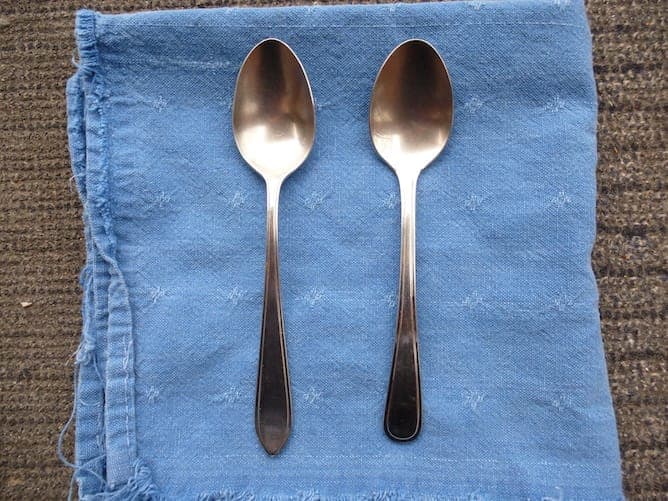
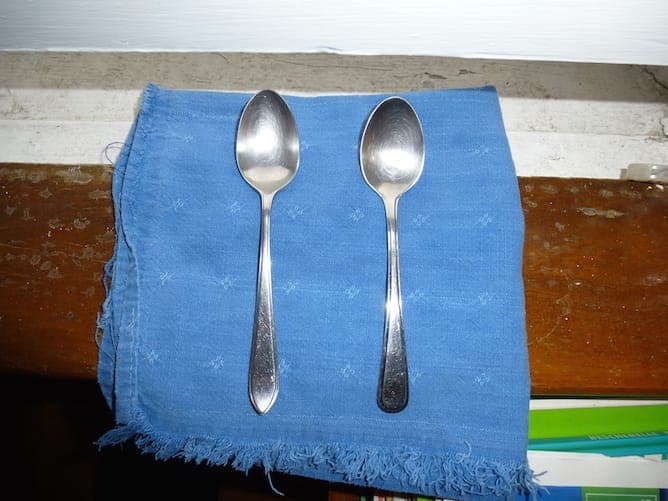
Both sets are duller than my new stainless steel set (from aging?) and heavier.
Any help would be appreciated.
- Toronto, Ontario, Canada
April 11, 2018
A. Hi Carole. There are tens of thousands if not hundreds of thousands of hallmarks, so even finding out who Cassera or Cassesa was, may be unlikely, and for them to have used only one composition for all their products, and for someone to know what that was, sounds quite unlikely. Or those words could be a model or pattern rather than maker. And determining its composition from a photo isn't possible. Sorry.
As for the Lagostina 18-10, the numbers are there to tell you that it is 18% chromium and 10% nickel.
Regards,

Ted Mooney, P.E. RET
Striving to live Aloha
finishing.com - Pine Beach, New Jersey
Q. Hi Ted. Thanks so much for taking the time to respond. Much appreciated.
With regard to your response to my question, would the Lagostina 18-10 (18% chromium and 10% nickel) be considered safe for cutlery that is used regularly?
Also, I see on the site that some people are using a magnet to detect the presence of nickel. Do you think this works?
- Toronto, Ontario, Canada
A. Tableware is an alloy of iron, chromium and nickel. Depending on the particular alloy it may be magnetic or not.
Your question seems to indicate that you are concerned about nickel in stainless steel.
People have been using nickel alloy stainless steel for a hundred years, and it is used in the cookware and tableware in every restaurant and 99% of homes.
Not to worry.

Jeffrey Holmes, CEF
Spartanburg, South Carolina
Q. Is vintage plated silverware from Italy that has quality issues such as: bends very easily, plating that looks granulated, built up in spots, and over all quality seems like it was pressed together when coated. Also the color seems funny, not quite shiny silver. Also I did try the magnet test which it did not stick to the utensils in question. My main concern is that these plated sets (it seems post WW2) could be an amalgam and not verifiable to standards such as lead free, etc.
L STALEY- Oakes, North Dakota, USA
July 11, 2018
A. Hi L. You left a word or two out; your posting includes no question. But it seems like you are largely convinced that it is unsafe to eat off of this flatware, but are hoping that someone will tell you otherwise so you can use it :-)
Good luck, but it's not going to be me claiming that some unknown 70 year old product from another country that you don't trust yourself is perfectly safe. Silver plating (if that's what it even is) wears through and exposes people to the substrate.
Regards,

Ted Mooney, P.E. RET
Striving to live Aloha
finishing.com - Pine Beach, New Jersey
How to clean old nickel-silver knife
Q. Hi, thanks for all this info. I have found an old knife in the back of a kitchen dresser I am doing up. The imprint says 'wear-site stainless nickel silver Sheffield '. I can see from an earlier post that it probably isn't even actually silver. I would like to clean it up. Can you recommend how to do this please? Julie
Julie Kiroluch- Mandurang, Victoria, Australia
August 22, 2018
A. Hi Julie. Indeed, it's probably nickel-silver and the word 'stainless' is probably a claim that it is "stain free", not implying that it is made of stainless steel.
Metal polish is your best bet, but depending on how old and how tarnished it is, it may not be possible to 'clean it up' without power buffing. But if something like Brasso doesn't work, and you don't want to do power buffing, you could try Barkeepers Friend ⇦ this on eBay or Amazon [affil links] .
Regards,

Ted Mooney, P.E. RET
Striving to live Aloha
finishing.com - Pine Beach, New Jersey
A.
Ortiz AJ, et al. Am J Orthod Dentofacial Orthop. 2011.
Abstract
INTRODUCTION: The aims of this study were to determine the amounts of metallic ions that stainless steel, nickel-free, and titanium alloys release to a culture medium, and to evaluate the cellular viability and DNA damage of cultivated human fibroblasts with those mediums.
METHODS: The metals were extracted from 10 samples (each consisting of 4 buccal tubes and 20 brackets) of the 3 orthodontic alloys that were submerged for 30 days in minimum essential medium. Next, the determination of metals was performed by using inductively coupled plasma mass spectrometry, cellular viability was assessed by using the tetrazolium reduction assay (MTT assay) (3-[4,5-dimethylthiazol-2-yl]-2, 5-diphenyltetrazolium bromide), and DNA damage was determined with the Comet assay. The metals measured in all the samples were Ti(47), Cr(52), Mn(55), Co(59), Ni(60), Mo(92), Fe(56), Cu(63), Zn(66), As(75), Se(78), Cd(111), and Pb(208).
RESULTS: The cellular viability of the cultured fibroblasts incubated for 7 days with minimum essential medium, with the stainless steel alloy submerged, was close to 0%. Moreover, high concentrations of titanium, chromium, manganese, cobalt, nickel, molybdenum, iron, copper, and zinc were detected. The nickel-free alloy released lower amounts of ions to the medium. The greatest damage in the cellular DNA, measured as the olive moment, was also produced by the stainless steel alloy followed by the nickel-free alloy. Conversely, the titanium alloy had an increased cellular viability and did not damage the cellular DNA, as compared with the control values.
CONCLUSIONS: The titanium brackets and tubes are the most biocompatible of the 3 alloys studied."
Copyright © 2011 American Association of Orthodontists. Published by Mosby, Inc. All rights reserved.
PMID 21889059 [Indexed for MEDLINE]
Full text at journal site
Habitat of Health - Yzerfontein Westcoast South Africa
![]() I am grateful for your rational approach. Today I purchased a "vintage" silver plated serving spoon, spent hours researching the mark - WA Italy - was pretty frustrated with the results, so then decided to worry about using the spoon because there were a couple of scratches. (Fortunately, this is not the site for absurdities). Dietary nickel. Found in wonderfully healthy food. Foods contain many elements. As you have said, Mr. Mooney, it's the food that is on the fork or spoon that is important, and I don't plan on sucking on the serving spoon without anything on it.
I am grateful for your rational approach. Today I purchased a "vintage" silver plated serving spoon, spent hours researching the mark - WA Italy - was pretty frustrated with the results, so then decided to worry about using the spoon because there were a couple of scratches. (Fortunately, this is not the site for absurdities). Dietary nickel. Found in wonderfully healthy food. Foods contain many elements. As you have said, Mr. Mooney, it's the food that is on the fork or spoon that is important, and I don't plan on sucking on the serving spoon without anything on it.
- Camden, Maine, USA
January 12, 2020
Q. I purchased a used hammered silver-plate flatware set. At the time it was dark silver but with a definable orange coloured cast to it. I have never seen that in silver-plate before, but I digress, we have been using it. Today while eating a frozen ice alcoholic desert with a spoon I noticed silver flecks. The back of the spoon was peeling off exposing a bright silver finish? What have I bought? is this safe? I tested the knives with a magnet and only the blades are magnetic
- toronto Ontario
April 20, 2020
A. Hi Sheila. No one is likely to actually know from such a description exactly what you bought or what's going on.
But as a guess, it has been replated and the contraction of the base metal due to the coldness of the iced dessert is revealing that the plating is not adhering to the base properly and is flaking off. A few tiny flecks of silver (if that's what the plating actually is) probably isn't very dangerous, but personally I wouldn't use such flatware.
Regards,

Ted Mooney, P.E. RET
Striving to live Aloha
finishing.com - Pine Beach, New Jersey
April 2020
Q. Hello, I tried to read this whole thread searching for some answers to my inquiry but in the end I decided to actually ask the question and I would be so grateful if someone can help me. So I have a few old spoons and forks that look like they are made of not lacquered brass. They are not shiny, they stain very easily with a touch of just any solid or liquid food and they emit a not particularly pleasant smell. So eventually I stopped using them despite liking how they look (they do have a nice antique look). But I'm still curious what they are made of, maybe they need some special cleaning, maybe they shouldn't be touched at all. After looking more carefully some of them have stamps on that say ALPACCA PB&F. I searched what that meant and it confused me even more as what is known as alpacca alloy is supposed to look like silver (and not yellowish...like brass) as for PB&F part...no clue at all, couldn't find anything. So can any help me to identify what is this metal?
Galyna Sishchuk- Paris France
April 28, 2020
A. Hi Galyna. There are sites which will, for a fee, research such matters if it's quite important to you.
But this is just a public forum, so don't hold your breath because everyone wants to know what they have, but doesn't much care about some article someone else has. So, while this site has thousands of questions that have inspired active public discussions, "what does this mark mean" hasn't been one of them. Sorry :-)
Regards,

Ted Mooney, P.E. RET
Striving to live Aloha
finishing.com - Pine Beach, New Jersey
April 2020
April 28, 2020
Q. Hello Mr. Mooney!
Thank you for your answer! I really appreciate it!
I must have worded my message badly. I understand that it's hard or impossible to know what the mark means. And I looked for it on the internet myself without much success. I just mentioned it in case it could help identify the metal this cutlery is made of. So my point was that I got confused as I read on different websites as well as here that alpacca alloy is supposed to look like silver (that's why I posted my question here). And yet the cutlery I have looks more like unlacquered brass. It's not shiny, it stains easily and has a smell when used. The main question for me is what is it? And is it safe?
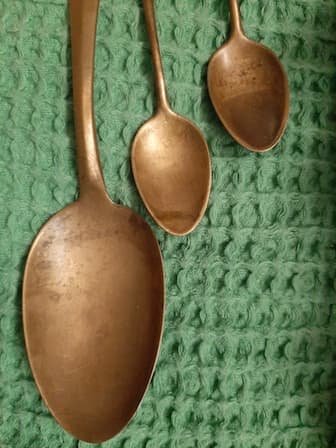
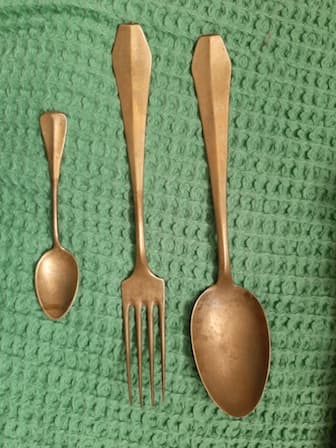
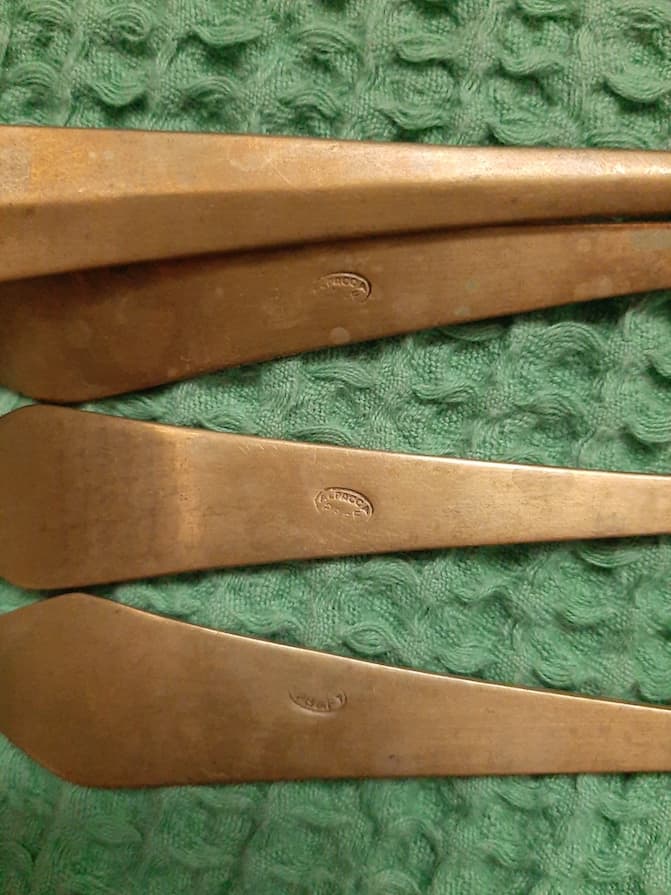

I'm terribly sorry if this is not the right place to ask my question.
Thank You and best regards!
- Paris, France
A. Hi again, Galyna. Of course your questions and pics are welcome. I'm just saying that you're unlikely to see authoritative responses telling you that it's safe or unsafe, or exactly what it is; and to be prepared for your question probably not generating robust enthusiastic public discussion -- not because of where you posted it but because of human nature. But, as we see on Facebook, it's also human nature to try to prove someone else wrong; so hopefully my saying that nobody is likely to respond will inspire readers to do it :-)
Personally, I would not eat off of them nor attempt to lacquer them for the purpose of eating off of though.
Regards,

Ted Mooney, P.E. RET
Striving to live Aloha
finishing.com - Pine Beach, New Jersey
April 2020
April 30, 2020
![]() Hello! Thank You very much for taking time to respond! I really appreciate it.
Hello! Thank You very much for taking time to respond! I really appreciate it.
In the meantime I'll just wait if maybe someone has any answers.
Best regards!
- Paris, France
My question is, I am thinking of nickel plating a pan using electro-plating method and use the nickel plated pan for my daily cooking. What is your advise in this regard?
sridharan s- Bengaluru, India
June 15, 2020
A. Hi sridharan. Some people worry even about austenitic steel with much lower and less leachable nickel content. And nickel is allergenic to a lot of people; so I don't think it's a great idea. Even then, I'm assuming you're a skilled nickel plater and won't have to worry about flakes or shards of nickel chipping off.
Regards,

Ted Mooney, P.E. RET
Striving to live Aloha
finishing.com - Pine Beach, New Jersey
June 2020
Q. Hi!
I inherited a silverware set marked "Nickel silver - Japan". I believe it to be Eldan ELD15 but not 100% sure. Am I understanding correctly that there is NO silver at all in it? If that is the case, it safe to eat from? Thank you for any help you can provide, I was planning to use it during the holidays, but not if it's toxic :(
- Dalton, Georgia, USA
July 2, 2020
A. Hi Lisa. It is true that nickel-silver contains no silver. It is the material from which most silver plated flatware is made, i.e., what is under the silver plating. It tends to look yellowish and to have a metallic taste. Does your flatware looks yellowish? Does it have a bad metallic taste? If not, it's probably conventional silverplated nickel-silver.
While people would like the world to be divided into safe and unsafe, toxic and non-toxic, it's just not. Rather, things are "safe enough" for you or they're not... Would you drive a car without the automatic braking of the last couple of model years? Would you drive a 1960's or early 1970's car without ABS brakes? Would you drive a car without airbags? Would you drive in the rain without super-premium wet-traction tires?
The principal issue with unplated nickel-silver is the color & taste. If flatware was made in Japan, and looks good, and has no metallic taste, I'd use it without any qualms.
Luck & Regards,

Ted Mooney, P.E. RET
Striving to live Aloha
finishing.com - Pine Beach, New Jersey
July 2020
Q, A, or Comment on THIS thread -or- Start a NEW Thread